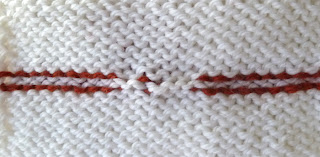Over the past few months I've been doing battle with my Adrift top (I hereby vow, in public, that I am never knitting laceweight again!). It is gorgeous, but my god, the stitches pull! Every time my dogs even look at it, I swear, there's another pulled stitch. And my fingernails. Some of them are very obvious, with an unsightly row of pulled stitches across whole swathes of the top.
So I have spent hours and hours and hours trying to tease out these pulled stitches, in lace weight. Which is a fucking pain in the arse. All my forays into looking for advice on 'fixing pulled stitches' just say to 'ease out the pulled threads' and nothing much else. Which really didn't help with the mess I was in. And I suspect that 'fixing pulled stitches' is going to be a constant part of the care for this garment.
But last week, suddenly my technique — which, frankly, hadn't been that successful up til then — suddenly improved. I've got the knack!
So I've made this little tutorial to help you, too, if you're battling with large areas of damage and pulled stitches. I'm using 8 ply in this sample, and the pulled row is in red, but obviously in your own knitting, your pulled thread row will probably be in the same colour as the background (which is what makes the task tricky).
So I've made this little tutorial to help you, too, if you're battling with large areas of damage and pulled stitches. I'm using 8 ply in this sample, and the pulled row is in red, but obviously in your own knitting, your pulled thread row will probably be in the same colour as the background (which is what makes the task tricky).
1) Here is your lovely smooth knitting, with a nice red stripe.
2) Oh noes! Some naughty puppy claw has caught on your work, and pulled.
3) This is what it looks like on the wrong side. Not good.
4) Pull the 'loose' yarn through to the wrong side of your work, using a blunt pin or darning needle. I find it easier to correct the mistakes when looking at the wrong side of the knitting, but if you prefer to work on the front, then just skip this step. The basic principles are the same.
5) Now, the main trick is this: you need to 'read' your knitting, and trace the path that the single row's yarn takes. The photo below illustrates this path. Use a blunt needle or pin to pull the loose yarn along the path of the knitting, slowly easing out the stitches until all the pulled stitches are back to their proper size, and the loop of pulled yarn is sitting back into the row where it belongs. A bright light helps.
6) So, to follow the direction of the stitches, you'll first pull an upper thread (purl bump), and then a lower thread (another purl bump), then the next upper, then the next lower, and so on along the row.
7) Work outwards from the main loop of loose yarn in the middle of the pulled area, outwards, first one side then the other. Upper loop, lower loop, upper, lower, in order, all the way along.

Keep on in this manner, closely looking for where the path of the pulled yarn is going, and pulling gradually, from the middle out to the edges of the pulled row, until first one half, and then the second half of the yarn is pulled back into its proper position. Keep checking your progress on the other side of the knitting.









